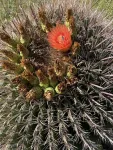(Press-News.org) Spending time in nature is good for us. Studies have shown that contact with nature can lift our well-being by affecting emotions, influencing thoughts, reducing stress and improving physical health. Even brief exposure to nature can help. One well-known study found that hospital patients recovered faster if their room included a window view of a natural setting.
Knowing more about nature’s effects on our bodies could not only help our well-being, but could also improve how we care for land, preserve ecosystems and design cities, homes and parks. Yet studies on the benefits of contact with nature have typically focused primarily on how seeing nature affects us. There has been less focus on what the nose knows. That is something a group of researchers wants to change.
“We are immersed in a world of odorants, and we have a sophisticated olfactory system that processes them, with resulting impacts on our emotions and behavior,” said Gregory Bratman, a University of Washington assistant professor of environmental and forest sciences. “But compared to research on the benefits of seeing nature, we don’t know nearly as much about how the impacts of nature’s scents and olfactory cues affect us.”
In a paper published May 15 in Science Advances, Bratman and colleagues from around the world outline ways to expand research into how odors and scents from natural settings impact our health and well-being. The interdisciplinary group of experts in olfaction, psychology, ecology, public health, atmospheric science and other fields are based at institutions in the U.S., the U.K., Taiwan, Germany, Poland and Cyprus.
At its core, the human sense of smell, or olfaction, is a complex chemical detection system in constant operation. The nose is packed with hundreds of olfactory receptors, which are sophisticated chemical sensors. Together, they can detect more than one trillion scents, and that information gets delivered directly to the nervous system for our minds to interpret — consciously or otherwise.
The natural world releases a steady stream of chemical compounds to keep our olfactory system busy. Plants in particular exude volatile organic compounds, or VOCs, that can persist in the air for hours or days. VOCs perform many functions for plants, such as repelling herbivores or attracting pollinators. Some researchers have studied the impact of exposures to plant VOCs on people.
“We know bits and pieces of the overall picture,” said Bratman. “But there is so much more to learn. We are proposing a framework, informed by important research from many others, on how to investigate the intimate links between olfaction, nature and human well-being.”
Nature’s smell-mediated impacts likely come through different routes, according to the authors. Some chemical compounds, including a subset of those from the invisible realm of plant VOCs, may be acting on us without our conscious knowledge. In these cases, olfactory receptors in the nose could be initiating a “subthreshold” response to molecules that people are largely unaware of. Bratman and his co-authors are calling for vastly expanded research on when, where and how these undetected biochemical processes related to natural VOCs may affect us.
Other olfactory cues are picked up consciously, but scientists still don’t fully understand all their impacts on our health and well-being. Some scents, for example, may have “universal” interpretations to humans — something that nearly always smells pleasant, like a sweet-smelling flower. Other scents are closely tied to specific memories, or have associations and interpretations that vary by culture and personal experience, as research by co-author Asifa Majid of the University of Oxford has shown.
“Understanding how olfaction mediates our relationships with the natural world and the benefits we receive from it are multi-disciplinary undertakings,” said Bratman. “It involves insights from olfactory function research, Indigenous knowledge, Western psychology, anthropology, atmospheric chemistry, forest ecology, Shinrin-yoku — or ‘forest bathing’ — neuroscience, and more.”
Investigation into the potential links between our sense of smell and positive experiences with nature includes research by co-author Cecilia Bembibre at University College London, which shows that the cultural significance of smells, including those from nature, can be passed down in communities to each new generation. Co-author Jieling Xiao at Birmingham City University has delved into the associations people have with scents in built environments and urban gardens.
Other co-authors have shown that nature leaves its signature in the very air we breathe. Forests, for example, release a complex chemical milieux into the air. Research by co-author Jonathan Williams at the Max Planck Institute for Chemistry and the Cyprus Institute shows how natural VOCs can react and mix in the atmosphere, with repercussions for olfactory environments.
The authors are also calling for more studies to investigate how human activity alters nature’s olfactory footprint — both by pollution, which can modify or destroy odorants in the air, and by reducing habitats that release beneficial scents.
“Human activity is modifying the environment so quickly in some cases that we’re learning about these benefits while we’re simultaneously making them more difficult for people to access,” said Bratman. “As research illuminates more of these links, our hope is that we can make more informed decisions about our impacts on the natural world and the volatile organic compounds that come from it. As we say in the paper, we live within the chemical contexts that nature creates. Understanding this more can contribute to human well-being and advance efforts to protect the natural world.”
Other UW co-authors on the paper are Peter Kahn, profess of psychology; Connor Lashus, a graduate student in the School of Environmental and Forest Sciences; and Anne Riederer, a clinical associate professor of environmental and occupational health sciences. Additional co-authors are Gretchen Daily of Stanford University; Richard Doty at the University of Pennsylvania; Thomas Hummel of the Dresden University of Technology; Lucia Jacobs of the University of California, Berkeley; John Miller of Wildwood|Mahonia; Anna Oleszkiewicz of the University of Wrocław; Hector Olvera-Alvarez of Oregon Health and Sciences University; Valentina Parma of the Monell Chemical Senses Center; Nancy Long Sieber and John Spengler of Harvard University; and Chia-Pin Yu of National Taiwan University.
###
For more information, contact Bratman at bratman@uw.edu.
END
Scientists want to know how the smells of nature benefit our health
2024-05-15
ELSE PRESS RELEASES FROM THIS DATE:
Singing researchers find cross-cultural patterns in music and language
2024-05-15
Language and music may share evolutionary functions. Both speech and song have features such as rhythm and pitch. But are similarities and differences between speech and song shared across cultures?
To investigate this question, 75 researchers—speaking 55 languages—were recruited across Asia, Africa, the Americas, Europe and the Pacific. Among them were experts in ethnomusicology, music psychology, linguistics, and evolutionary biology. The researchers were asked to sing, perform instrumentals, ...
Killer whales breathe just once between dives, study confirms
2024-05-15
A new study has confirmed a long-held assumption: that orcas take just one breath between dives.
The researchers used drone footage and biological data from tags suction-cupped to 11 northern and southern resident killer whales off the coast of B.C. to gather information on the animals’ habits.
Whaley fun facts
Published in PLOS ONE, the study found that residents spend most of their time making shallow dives, with the majority of dives less than one minute. The longest dive recorded was 8.5 minutes, for an adult male. “Killer whales are like sprinters who don’t have the marathon endurance of blue and humpback whales to make deep and prolonged dives,” ...
Bees and butterflies on the decline in western and southern North America
2024-05-15
Bee and butterfly populations are in decline in major regions of North America due to ongoing environmental change, and significant gaps in pollinator research limit our ability to protect these species, according to a study published May 15, 2024 in the open-access journal PLOS ONE by Sara Souther of Northern Arizona University, US, and colleagues.
Recent research has detected declines in populations of pollinator species, sparking alarm from scientists and policymakers concerned about negative impacts on ecosystems and agriculture. These declines have been linked to various factors including climate change, habitat loss, and invasive species, but ...
Singing researchers investigate cross-cultural patterns in music, language
2024-05-15
Seventy-five researchers from 46 countries recorded themselves performing traditional music and speaking in their own languages in a novel experiment investigating cross-cultural differences and similarities.
With rare exceptions, the rhythms of songs and instrumental melodies were slower than for speech, while the pitches were higher and more stable, according to the study published in Science Advances.
Unique for the number of languages represented – 55 – and the diversity of the researchers, the study provides “strong evidence for cross-cultural regularities,” according to senior author Dr Patrick ...
Animal brain inspired AI game changer for autonomous robots
2024-05-15
A team of researchers at Delft University of Technology has developed a drone that flies autonomously using neuromorphic image processing and control based on the workings of animal brains. Animal brains use less data and energy compared to current deep neural networks running on GPUs (graphic chips). Neuromorphic processors are therefore very suitable for small drones because they don’t need heavy and large hardware and batteries. The results are extraordinary: during flight the drone’s deep neural network processes data up to 64 times faster and consumes three times less energy than when running on a GPU. Further developments of this technology may ...
Summers warm up faster than winters, fossil shells from Antwerp show
2024-05-15
Niels de Winter, affiliated with the Department of Earth Sciences at Vrije Universiteit Amsterdam and the AMGC research group at Vrije Universiteit Brussel, measured alongside colleagues from institutions such as the Institute for Natural Sciences in Brussels the chemical composition of fossil shells from Antwerp, Belgium. Those shells originate from molluscs such as oysters, cockles, and scallops found during the construction works of the Kieldrecht Lock. The molluscs lived lived during the Pliocene, approximately ...
Wearing face masks did not reduce risk of COVID infection after first Omicron wave, research shows
2024-05-15
After the first Omicron wave, research shows that many of the risks of Covid infection changed
Before February 2022, always wearing face masks and being retired were associated with reduced risk, but not after
Overseas travel was not associated with increased risk prior to February 2022, but then became a significant risk
Peer reviewed – meta-regression- humans
New research from the University of East Anglia has found that wearing face masks did not lower the risk of Covid infection following the initial surge of the Omicron variant.
The analysis of official data found that several risk ...
SF State receives $14M from the Genentech Foundation to support underrepresented students in STEM
2024-05-15
SAN FRANCISCO – May 15, 2024 – San Francisco State University announced today that it received $14 million from the Genentech Foundation to support two University programs that are training the next generation of life sciences leaders. The new five-year grant is the latest in the Genentech Foundation’s transformational support for University programs, which has totaled more than $33 million during their long-lasting partnership. This partnership has impacted more than 700 students since 2008, and an additional 350 students are projected to be supported by the new funding.
The new funds will continue sponsoring San Francisco State’s Genentech ...
Penalties for dropping out of ecosystem services incentive programs should equal lost environmental benefits
2024-05-15
Payment for Ecosystem Services programs (PES) are important tools that governments around the world use to improve water quality, protect forests and wildlife habitat, and sequester carbon. Under these programs, landowners - usually farmers - are paid to use their land in ways that protect or restore the environment, such as replacing row crops with trees or grassy zones adjacent to waterways. Many PES program contracts last 5 to 20 years, but participant drop out rates have consistently risen over the years.
A recent study by University of Maryland economists showed that PES programs ...
Lithuanian researchers’ new development in solar cell technology – a promise of a significant advancement in the field
2024-05-15
Researchers from Kaunas University of Technology (KTU), Lithuania, who contributed to the development of record-breaking solar cells a few years ago, expanded their invention. The self-assembled monolayers can now be applied not only in inverted but also in regular structure perovskite solar cells.
Self-assembling molecules arrange themselves into a single-molecule-thick layer and in this case, they act as an electron-transporting layer in solar cells.
“The molecules that make up these monolayers, like a clever glue, ...




